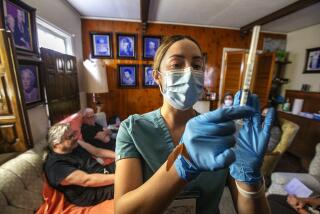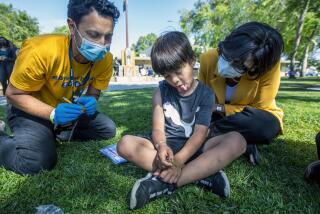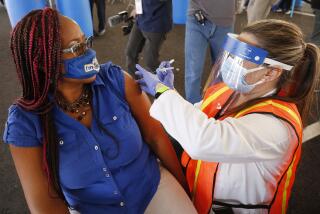Smallpox Drill Tests County’s Readiness
- Share via
Nearly 1,400 people walked by tranquil water fountains and statues of biblical figures at the Crystal Cathedral on Wednesday, just before they passed a sign reading, “Welcome to the Smallpox Exercise.”
The Orange County Health Care Agency, in conjunction with the county’s American Red Cross chapter and other organizations, staged the mock smallpox immunization drill at the cathedral in Garden Grove; no one was actually given the vaccine.
The drill was part of a mandate from the Centers for Disease Control and Prevention, said Dr. Mark Horton, deputy agency director for public health. The CDC provides terrorism defense funding to public health agencies through grants to states. Orange County received about $4 million this year.
The drill came as the federal government warned that a terror cell might be planning a major attack in the U.S. this summer. The smallpox drill, however, had been planned more than a year ago.
Organizing and conducting the drill was “a huge challenge,” Horton said. “Things have changed since 9/11. Public health agencies, like law enforcement and fire agencies, have gotten this on their radar screen.”
Smallpox, however, would seem an odd choice for the drill, considering few health care workers volunteered for vaccination after President Bush asked for at least 450,000 inoculations by last year. According to the CDC, 39,512 workers nationwide, 1,611 in California, had been vaccinated as of April 30.
But that’s why it’s important to prepare for smallpox, Horton said.
“In the event that this really happens, we have to plan to vaccinate a lot of people quickly,” he said. Horton said smallpox vaccine is difficult to administer: The real vaccine requires a small needle or pin dipped in the vaccine to be lightly jabbed into a person’s arm multiple times, as opposed to one injection.
According to the CDC, the vaccine can cause fever, rash, myopericarditis (an inflammation of the heart and surrounding membranes) or encephalitis (a swelling of the brain). About one person in a million could die from complications related to the vaccine.
But Horton said the skills learned here could be applied to other public health emergencies such as earthquakes, widespread fire and other disease outbreaks.
Volunteers were given manila folders containing their mock health information. Colored duct tape on the ground led people to different destinations, including red for first responders, such as firefighters and police officers, and white for people who did not speak English. Some people were dotted with makeup that simulated the smallpox rash. They were sent by ambulance to the UC Irvine Medical Center, which ran its own drill.
Volunteers rolled up their sleeves for latex-gloved nurses who dabbed cotton swabs onto their arms to simulate inoculation. The nurses disposed used swabs in biohazard containers. They taped cotton balls to the “injection” sites.
But it wasn’t a perfect simulation. There were no children or panicky patients, although some were instructed to behave nervously. And some of the volunteers also didn’t move along as quickly as they had hoped.
Adam Frey, 21, waited in line for more than two hours before he was vaccinated. “No one’s come up to me to ask me anything or answer my questions,” he said. “I was told they would.”
But Ryan Drabek, an animal control officer, was in the first responder line and got through in about 10 minutes.
“That made me feel pretty good because you want the first responders out and about doing their thing when something like this happens,” he said.
Jane Lee, an employee of the county healthcare agency, said preparing for bioterrorism is a necessity.
“We have to face up to the facts. This is the world we live in now,” she said. “You don’t have to be scared if you’re ready.”
More to Read
Sign up for Essential California
The most important California stories and recommendations in your inbox every morning.
You may occasionally receive promotional content from the Los Angeles Times.













